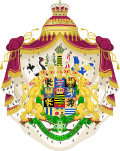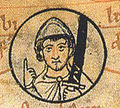| Ruler | Born | Reign | Death | Ruling part | Consort | Notes |
|---|
Frederick I the Warlike
(Friedrich der Streitbare) |  | 11 April 1370 | 6 January 1423 – 4 January 1428 | 4 January 1428 | Duchy of Saxony and Electorate of Saxony | Catherine of Brunswick-Lüneburg
7 February 1402
seven children | After the Wittenberg line of the Ascanians became extinct, the Electorate was given to Frederick, Margrave of Meissen and Landgrave of Thuringia, of the House of Wettin. |
Frederick II the Gentle
(Friedrich der Sanftmütige) |  | 22 April 1412 | 4 January 1428 – 7 September 1464 | 7 September 1464 | Duchy of Saxony and Electorate of Saxony | Margaret of Austria
3 June 1431
Leipzig
eight children | Son of Frederick I. Ruled jointly in Saxony with his brothers, but was the sole holder of the Electorate. Father of Ernest and Albert, founders of the Ernestine and Albertine Saxon lines. |
Ernest I
(Ernst) |  | 24 March 1441 | 7 September 1464 – 26 August 1486 | 26 August 1486 | Ernestine
Electorate of Saxony | Elisabeth of Bavaria-Munich
25 November 1460
Leipzig
seven children | Son of Frederick II. He was the founder and progenitor of the Ernestine line of Saxon princes. |
| Albert III the Bold |  | 27 January 1443 | 1464–1500 | 12 September 1500 | Albertine
Duchy of Saxony | Sidonie of Poděbrady
11 November 1464
Cheb
nine children | Son of Frederick II. He was the founder and progenitor of the Albertine line of Saxon princes. |
Frederick III the Wise
(Friedrich der Weise) |  | 17 January 1463 | 26 August 1486 – 5 May 1525 | 5 May 1525 | Ernestine
Electorate of Saxony | Unmarried | Son of Ernest. Protector of Martin Luther, but a lifelong Catholic. Left no male descendants. Ruled jointly with his brother John, who succeeded him. |
| George I the Bearded |  | 27 August 1471 | 1500–1539 | 17 April 1539 | Albertine
Duchy of Saxony | Barbara of Poland
21 November 1496
Dresden
ten children | Proponent of Catholic Reform and a staunch opponent of Martin Luther. Left no surviving male descendants. He was succeeded by his brother Henry. |
John I the Steadfast
(Johann der Beständige) |  | 30 June 1468 | 5 May 1525 – 16 August 1532 | 16 August 1532 | Ernestine
Electorate of Saxony | Sophie of Mecklenburg
1 March 1500
Torgau
one child
Margaret of Anhalt-Köthen
13 November 1513
Torgau
four children | Co-regent of his brother Frederick III (26 August 1486 – 5 May 1525), with his own residence at Weimar since 1513. Established Lutheranism in his territories in 1527. |
John Frederick I the Magnanimous
(Johann Friedrich I der Großmütige) |  | 30 June 1503 | 16 August 1532 – 19 May 1547 | 3 March 1554 | Ernestine
Electorate of Saxony | Sibylle of Cleves
9 February 1527
Torgau
four children | Lost his Electoral dignity and territory to his cousin Maurice after being defeated by the Emperor in the Schmalkaldic War. He was left with some territories as the Duchy of Saxony. After his death the Duchy of Saxony was divided between his three sons. |
| 19 May 1547 – 1554 | Ernestine
Duchy of Saxony |
| John Ernest I |  | 10 May 1521 | 16 August 1532 – 8 February 1553 | 8 February 1553 | Ernestine
Saxe-Coburg | Catherine of Brunswick-Grubenhagen
12 February 1542
Torgau
no children | Until 1542, John Ernest was co-regent of his brother, Elector John Frederick I. When John Frederick decided to rule alone, he created the Duchy of Saxe-Coburg for his brother. After his death without descendants, the land reverted to John Frederick. |
| Henry IV the Pious |  | 16 March 1473 | 1539–1541 | 18 August 1541 | Albertine
Duchy of Saxony | Catherine of Mecklenburg
69 January 1541
Marburg
nine children | Succeeded his brother George I. He established Lutheranism in Albertine Saxony. |
Maurice I
(Moritz) |  | 21 March 1521 | 1541–1547 | 9 July 1553 | Albertine
Duchy of Saxony | Agnes of Hesse
9 January 1541
Marburg
two children | Second cousin of John Frederick, grandson of Albert. Though a Lutheran, allied with Emperor Charles V against the Schmalkaldic League. Gained the Electorate for the Albertine line in 1547 after Charles V's victory at the Battle of Mühlberg. Left no male descendants. He was succeeded by his brother Augustus. |
| 4 June 1547 – 9 July 1553 | Albertine
Electorate of Saxony |
| Following their displacement by the Albertines, the Ernestine branch of the Wettins continued to rule in southern Thuringia as "Dukes of Saxony", but their lands eventually split up into many different tiny Ernestine duchies. |
Augustus I
(August) |  | 31 July 1526 | 9 July 1553 – 11 February 1586 | 11 February 1586 | Albertine
Electorate of Saxony | Anna of Denmark
7 October 1548
Torgau
fifteen children
Agnes Hedwig of Anhalt
3 January 1586
Dessau
no children | Brother of Maurice. Recognized as Elector by the ousted John Frederick I in 1554. From 1573 he was also regent for Frederick William, in the Ernestine duchy of Saxe-Weimar. |
| John Frederick II |  | 8 January 1529 | 1554–1565 | 19 May 1595 | Ernestine
Saxe-Coburg -Eisenach | Agnes of Hesse
26 May 1555
Weimar
no children
Elisabeth of the Palatinate-Simmern-Sponheim
12 June 1558
Weimar
four children | Received Saxe-Weimar. In 1565 united his domains with those of his younger brother in Gotha. In 1566 abdicated in favor of his brother John William, who reunited the duchy. |
| 1565–1566 | Ernestine
Saxe-Coburg -Eisenach and Saxe-Gotha |
| John Frederick III the Younger |  | 16 January 1538 | 1554–1565 | 21 October 1565 | Ernestine
Saxe-Gotha | Unmarried | Received Saxe-Gotha. However he left its administration to his elder brothers. After his death, his domains were annexed by his elder brother. |
| John William I |  | 11 March 1530 | 1554–1566 | 2 March 1573 | Ernestine
Saxe-Weimar | Dorothea Susanne of the Palatinate-Simmern
15 June 1560
Heidelberg
five children | Received Saxe-Weimar. In 1565 united his domains with those of his younger brother in Gotha. Reunited Saxony in 1566, after the abdication of his older brother. In 1572, the Division of Erfurt divided Saxony once again, between John William and his nephews, sons of John Frederick II. He received once more Saxe-Weimar. |
| 1566–1572 | Ernestine
Duchy of Saxony |
| 1572–1573 | Ernestine
Saxe-Weimar |
| John Casimir |  | 12 June 1564 | 1572–1596 | 16 July 1633 | Ernestine
Saxe-Coburg -Eisenach | Anna of Saxony
16 January 1586
Dresden
no children
Margaret of Brunswick-Lüneburg
16 September 1599
Coburg
no children | Sons of John Frederick II, ruled jointly. In 1596 divided the land. John Casimir received Saxe-Coburg and John Ernest received Saxe-Eisenach. In 1633 John Casimir died without descendants and John Ernest reunited again Saxe-Coburg-Eisenach. However, as he also didn't have heirs, the duchies were divided between its neighbours Saxe-Altenburg and Saxe-Weimar. |
| 1596–1633 | Ernestine
Saxe-Coburg |
| John Ernest I |  | 9 July 1566 | 1572–1596 | 23 October 1638 | Ernestine
Saxe-Coburg -Eisenach | Elisabeth of Mansfeld-Hinterort
23 November 1591
Wiener Neustadt
one child
Christine of Hesse-Kassel
14 May 1598
Rotenburg an der Fulda
no children |
| 1596–1633 | Ernestine
Saxe-Eisenach |
| 1633–1638 | Ernestine
Saxe-Coburg -Eisenach |
| Saxe-Coburg-Eisenach divided between its neighbours Saxe-Altenburg and Saxe-Weimar |
| Regency of Augustus I, Elector of Saxony (1573-1586) | After his death, his brother took the land and in the next year divided it with his nephews (sons of Frederick William). |
| Frederick William I |  | 25 April 1562 | 1573–1602 | 7 July 1602 | Ernestine
Saxe-Weimar | Sophie of Württemberg
5 May 1583
Weimar
six children
Anna Maria of the Palatinate-Neuburg
9 September 1591
Neuburg an der Donau
six children |
Christian I
(Christian I) |  | 29 October 1560 | 11 February 1586 – 25 September 1591 | 25 September 1591 | Albertine
Electorate of Saxony | Sophie of Brandenburg
25 April 1582
Dresden
seven children | |
| Regency of Sophie of Brandenburg (1591-1601) | |
Christian II
(Christian II) |  | 23 September 1583 | 25 September 1591 – 23 June 1611 | 23 June 1611 | Albertine
Electorate of Saxony | Hedwig of Denmark
12 September 1602
Dresden
no children |
| John II |  | 22 May 1570 | 1602–1605 | 18 July 1605 | Ernestine
Saxe-Weimar | Dorothea Maria of Anhalt
7 January 1593
Altenburg
twelve children | Divided Saxe-Weimar with his nephews in 1603, retaining a smaller Saxe-Weimar (sometimes called Saxe-Weimar-Jena). |
| John Philip |  | 25 January 1597 | 1603–1639 | 1 April 1639 | Ernestine
Saxe-Altenburg | Elisabeth of Brunswick-Wolfenbüttel
25 October 1618
Altenburg
one child | Received and ruled jointly the newly created Saxe-Altenburg, after the partition of 1603. None of them had male descendants. |
| Frederick |  | 12 February 1599 | 1603–1625 | 24 October 1625 | Ernestine
Saxe-Altenburg | Unmarried |
| John William | | 13 April 1600 | 1603–1632 | 2 December 1632 | Ernestine
Saxe-Altenburg | Unmarried |
| John Ernest I |  | 21 February 1594 | 1605–1626 | 6 December 1626 | Ernestine
Saxe-Weimar | Unmarried | Sons of John IV, ruled jointly. In 1640 divided the land. William kept Saxe-Weimar. In 1644 William reunited his own domains with Albert's. After William's death his domains were divided by his four sons. On the other hand, Ernest inherited Saxe-Gotha and reunited it with his wife's (as heiress of Saxe-Altenburg). |
| William I the Great |  | 11 April 1598 | 1626–1644 | 17 May 1662 | Ernestine
Saxe-Weimar | Eleonore Dorothea of Anhalt-Dessau
23 May 1625
Weimar
nine children |
| 1644–1662 | Ernestine
Saxe-Weimar and Saxe-Eisenach |
| Albert IV |  | 27 July 1599 | 1605–1640 | 20 December 1644 | Ernestine
Saxe-Weimar | Dorothea of Saxe-Altenburg
24 June 1633
Weimar
no children |
| 1640–1644 | Ernestine
Saxe (-Weimar) -Eisenach |
| Ernest I the Pious |  | 25 December 1601 | 1605–1640 | 26 March 1675 | Ernestine
Saxe-Weimar | Elisabeth Sophie of Saxe-Altenburg
24 October 1636
Altenburg
eighteen children |
| 1640–1672 | Ernestine
Saxe (-Weimar) -Gotha |
| 1672–1675 | Ernestine
Saxe-Gotha-Altenburg |
John George I
(Johann Georg I) |  | 5 March 1585 | 23 June 1611 – 8 October 1656 | 8 October 1656 | Albertine
Electorate of Saxony | Sibylle Elisabeth of Württemberg
16 September 1604
Dresden
one child
Magdalene Sibylle of Prussia
19 July 1607
Torgau
ten children | Brother of Christian II, ruled during the Thirty Years' War, during which he was at times allied with the Emperor and at times with the King of Sweden. |
| Frederick William II |  | 12 February 1602 | 1639–1669 | 22 April 1669 | Ernestine
Saxe-Altenburg | Sophie Elisabeth of Brandenburg
18 September 1638
Altenburg
no children
Magdalene Sibylle of Saxony
11 October 1652
Dresden
three children | Brother of John Philip, Frederick and John William. Succeeded his childless brothers. Received part of Saxe-Weimar-Eiesnach in 1638. |
John George II
(Johann Georg II) |  | 31 May 1613 | 8 October 1656 – 22 August 1680 | 22 August 1680 | Albertine
Electorate of Saxony | Magdalene Sibylle of Brandenburg-Bayreuth
13 November 1638
Dresden
three children | Elector, he also served as regent in Saxe-Altenburg for Frederick William III. The minor duke never reached adulthood. |
| Augustus I |  | 13 August 1614 | 1656–1680 | 4 June 1680 | Albertine
Saxe-Weissenfels | Anna Maria of Mecklenburg-Schwerin
23 November 1647
Schwerin
twelve children
Johanna Walpurgis of Leiningen-Westerburg
29 January 1672
Halle
three children | Son of Elector John George I. Inherited Saxe-Weissenfels. After his death, Weissenfels was divided. |
| Christian I |  | 27 October 1615 | 1656–1691 | 18 October 1691 | Albertine
Saxe-Merseburg | Christiana of Schleswig-Holstein-Sonderburg-Glücksburg
19 November 1650
Dresden
eleven children | Son of Elector John George I. Inherited Saxe-Merseburg. |
| Maurice I |  | 28 March 1619 | 1662–1681 | 4 December 1681 | Albertine
Saxe-Zeitz | Sophie Hedwig of Schleswig-Holstein-Sonderburg-Glücksburg
19 November 1650
Dresden
two children
Dorothea Maria of Saxe-Weimar
3 July 1656
Weimar
ten children
Sophie Elisabeth of Schleswig-Holstein-Sonderburg-Wiesenburg
14 June 1676
Wiesenburg
no children | Son of Elector John George I. Inherited Saxe-Zeitz. |
| Bernard II |  | 14 October 1638 | 1662–1678 | 3 May 1678 | Ernestine
Saxe-Jena | Marie Charlotte de la Trémoille
10 June 1662
Paris
five children | Son of William I. Received Saxe-Jena. |
| John Ernest II |  | 11 September 1627 | 1662–1683 | 15 May 1683 | Ernestine
Saxe-Weimar | Christine Elisabeth of Schleswig-Holstein-Sonderburg
14 August 1656
Weimar
five children | Son of William I. Received the remaining Saxe-Weimar. He also served as regent for his nephew, John William of Saxe-Jena. |
| Adolf William |  | 15 May 1632 | 1662–1668 | 21 November 1668 | Ernestine
Saxe-Eisenach | Marie Elisabeth of Brunswick-Wolfenbüttel
18 January 1663
Wolfenbüttel
five children | Son of William I. Received Saxe-Eisenach. |
| Regency of John George I, Duke of Saxe-Marksuhl (1668-1671) | Died as a minor. His uncle, as regent, inherited his domain. |
| William August | | 30 November 1668 | 1668–1671 | 23 February 1671 | Ernestine
Saxe-Eisenach | Unmarried |
| John George I |  | 11 April 1598 | 1662–1671 | 17 May 1662 | Ernestine
Saxe-Marksuhl | Johannetta of Sayn-Wittgenstein
29 May 1661
Wallau
nine children | Son of William I. Received Saxe-Marksuhl. He also served as regent for his nephew William August in Saxe-Eisenach, but after his nephew's death in 1671, he inherited it himself, merging Marksuhl in Eisenach. From 1683 he also became regent for another nephew, John William III, in Saxe-Jena. |
| 1671–1686 | Ernestine
Saxe-Eisenach |
| Saxe-Marksuhl merged in Saxe-Eisenach |
| Regency of John George II, Elector of Saxony (1669-1672) | Son of Frederick William II. Died as a minor. His lands were divided between Saxe-Gotha and Saxe-Weimar. |
| Frederick William III |  | 12 July 1657 | 1669–1672 | 14 April 1672 | Ernestine
Saxe-Altenburg | Unmarried |
| Saxe-Altenburg merged in Saxe-Gotha to form Saxe-Gotha-Altenburg |
| Frederick I |  | 15 July 1646 | 1675–1691 | 2 August 1691 | Ernestine
Saxe-Gotha-Altenburg | Magdalena Sibylle of Saxe-Weissenfels
14 November 1669
Halle
eight children
Christine of Baden-Durlach
14 August 1681
Ansbach
no children | Son of Ernest I. Received Saxe-Gotha-Altenburg. |
| Albert V |  | 24 May 1648 | 1675–1699 | 6 August 1699 | Ernestine
Saxe-Coburg | Marie Elisabeth of Brunswick-Wolfenbüttel
18 July 1676
Gotha
one child
Susanne Elisabeth Kempinsky
24 May 1688
Coburg
(morganatic)
no children | Son of Ernest I. Received Saxe-Coburg. Left no male descendants. His lands were annexed by Saafeld. |
| Saxe-Coburg merged in Saxe-Saalfeld to form Saxe-Coburg-Saalfeld |
| Bernard I |  | 10 September 1649 | 1675–1706 | 27 April 1706 | Ernestine
Saxe-Meiningen | Marie Hedwig of Hesse-Darmstadt
20 November 1671
Gotha
seven children
Elisabeth Eleonore of Brunswick-Wolfenbüttel
25 January 1681
Schöningen
five children | Son of Ernest I. Received Saxe-Meiningen. He also served as regent, together with his brother Henry, for their nephew, Frederick II, in Saxe-Gotha-Altenburg. |
| Henry |  | 19 November 1650 | 1675–1710 | 13 May 1710 | Ernestine
Saxe-Römhild | Marie Elisabeth of Hesse-Darmstadt
1 March 1676
Darmstadt
no children | Son of Ernest I. Received Saxe-Römhild. Left no descendants and his lands were annexed to Saxe-Coburg-Saalfeld. He also served as regent, together with his brother Henry, for their nephew, Frederick II. |
| Saxe-Römhild was annexed by Saxe-Coburg-Saalfeld |
| Christian |  | 6 January 1653 | 1675–1707 | 28 April 1707 | Ernestine
Saxe-Eisenberg | Christiane of Saxe-Merseburg
13 February 1677
Merseburg
one child
Sophie Marie of Hesse-Darmstadt
9 February 1681
Darmstadt
no children | Son of Ernest I. Received Saxe-Eisenberg. Left no male descendants and his lands were annexed to Saxe-Hildburghausen. |
| Saxe-Eisenberg was annexed by Saxe-Hildburghausen |
| Ernest I |  | 12 June 1655 | 1675–1715 | 17 October 1715 | Ernestine
Saxe-Hildburghausen | Sophie of Waldeck
30 November 1680
Arolsen
eighteen children | Son of Ernest I of Saxe-Gotha. Received Saxe-Hildburghausen. |
| John Ernest |  | 22 August 1658 | 1675–1699 | 17 February 1729 | Ernestine
Saxe-Saalfeld | Sophie Hedwig of Saxe-Merseburg
18 February 1680
Merseburg
five children
Charlotte Johanna of Waldeck-Wildungen
2 December 1690
Maastricht
eight children | Son of Ernest I. Received Saxe-Saafeld. In 1699 reunified it with Saxe-Coburg, forming Saxe-Coburg-Saalfeld. |
| 1699–1729 | Ernestine
Saxe-Coburg-Saalfeld |
| Regencies of John Ernest II, Duke of Saxe-Weimar (1678-83), John George I, Duke of Saxe-Eisenach (1683-86) and William Ernest, Duke of Saxe-Weimar (1686-90) | Son of Bernard II. Died as a minor. |
| John William | | 28 March 1675 | 1678–1690 | 4 November 1690 | Ernestine
Saxe-Jena | Unmarried |
| Saxe-Coburg-Eisenach divided between its neighbours Saxe-Eisenach and Saxe-Weimar |
John George III
(Johann Georg III) |  | 20 June 1647 | 22 August 1680 – 12 September 1691 | 12 September 1691 | Albertine
Electorate of Saxony | Anna Sophie of Denmark
9 October 1666
Copenhagen
two children | |
| John Adolph I |  | 2 November 1649 | 1680–1697 | 24 May 1697 | Albertine
Saxe-Weissenfels-Querfurt | Johanna Magdalena of Saxe-Altenburg
25 October 1671
Altenburg
eleven children
Christiane Wilhelmine of Bünau
3 February 1692
Querfurt
(morganatic)
eleven children | Inherited the remaining Saxe-Weissenfels. |
| Henry |  | 29 September 1657 | 1680–1728 | 16 February 1728 | Albertine
Saxe-Weissenfels-Barby | Elisabeth Albertine of Anhalt-Dessau
30 March 1686
Dessau
seven children | Inherited Saxe-Weissenfels-Barby. |
| Maurice William |  | 12 March 1664 | 1681–1718 | 15 November 1718 | Albertine
Saxe-Zeitz | Marie Amalie of Brandenburg
25 June 1689
Potsdam
five children | Left no descendants. After his death Saxe-Zeitz merged in the Electorate. |
| Saxe-Zeitz merged in the Electorate of Saxony |
| William Ernest I |  | 19 October 1662 | 1683–1728 | 26 August 1728 | Ernestine
Saxe-Weimar | Charlotte Marie of Saxe-Jena
2 November 1683
Eisenach
no children | Ruled jointly. John Ernest was just a nominal ruler; William Ernest had full government. William Ernest also served as regent for his cousin, John William, in Saxe-Jena. |
| John Ernest III |  | 22 June 1664 | 1683–1707 | 10 May 1707 | Ernestine
Saxe-Weimar | Sophie Auguste of Anhalt-Zerbst
11 October 1685
Zerbst
five children
Charlotte of Hesse-Homburg
4 November 1694
Kassel
four children |
| Philip |  | 26 October 1657 | 1684–1690 | 1 July 1690 | Albertine
Saxe-Merseburg-Lauchstädt | Eleonore Sophie of Saxe-Weimar
9 July 1684
Weimar
two children
Louise Elisabeth of Württemberg-Oels
17 August 1688
Bernstadt
one child | Son of Christian. Received from his father the town of Lauchstädt, and ruled it in his father's lifetime. After his death his land returned to is father. |
| John George II |  | 24 July 1665 | 1686–1698 | 10 November 1698 | Ernestine
Saxe-Eisenach | Sophie Charlotte of Württemberg
20 September 1688
Kirchheim unter Teck
no children | Left no descendants. He was succeeded by his brother. |
John George IV
(Johann Georg IV) |  | 18 October 1668 | 12 September 1691 – 27 April 1694 | 27 April 1694 | Albertine
Electorate of Saxony | Eleonore Erdmuthe of Saxe-Eisenach
17 April 1692
Leipzig
no children | |
| Christian II | | 19 November 1653 | 1691–1694 | 20 October 1694 | Albertine
Saxe-Merseburg | Erdmuthe Dorothea of Saxe-Zeitz
14 October 1679
Moritzburg
seven children | |
| Augustus | | 15 February 1655 | 1691–1715 | 27 March 1715 | Albertine
Saxe-Merseburg-Zörbig | Hedwig of Mecklenburg-Güstrow
1 December 1686
Güstrow
eight children | Son of Christian. Received from his brother the town of Zörbig. Left no male descendants. His lands returned to Saxe-Merseburg. |
| Saxe-Merseburg-Zörbig merged in Saxe-Merseburg |
| Regencies of Bernhard I, Duke of Saxe-Meiningen and Henry, Duke of Saxe-Römhild (1691-1693) | |
| Frederick II |  | 28 July 1676 | 1691–1732 | 23 March 1732 | Ernestine
Saxe-Gotha-Altenburg | Magdalena Augusta of Anhalt-Zerbst
7 June 1696
Gotha
nineteen children |
Frederick Augustus I the Strong
(Friedrich August I) |  | 12 May 1670 | 27 April 1694 – 1 February 1733 | 1 February 1733 | Albertine
Electorate of Saxony | Christiane Eberhardine of Brandenburg-Bayreuth
20 January 1693
Bayreuth
one child | Brother of John George IV. Converted to Catholicism 1697 in order to compete for the crown of Poland. Took the Polish crown 1697, opposed by Stanisław Leszczyński, in 1704, forced to renounce the throne 1706, returned as monarch 1709 until his death. He also served as regent on behalf of Dukes Christian Maurice, and Maurice Wilhelm in Saxe-Merseburg. |
| Regencies of Erdmuthe Dorothea of Saxe-Zeitz and Frederick Augustus I, Elector of Saxony (1694-1712) | Both brothers left no descendants. Maurice William was succeeded by his uncle, Henry. |
| Christian III Maurice | | 7 November 1680 | 1694 | 14 November 1694 | Albertine
Saxe-Merseburg | Unmarried |
| Maurice William |  | 5 February 1688 | 1694–1731 | 21 April 1731 | Albertine
Saxe-Merseburg | Henriette Charlotte of Nassau-Idstein
4 November 1711
Istein
one child |
| Henry |  | 2 September 1661 | 1694–1731 | 28 July 1738 | Albertine
Saxe-Merseburg-Spremberg | Elisabeth of Mecklenburg-Güstrow
29 March 1692
Güstrow
three children | Son of Christian. Received from his brother the town of Spremberg. In 1731 succeeded in Saxe-Merseburg, reuniting its original lands with those he unexpectedly inherited. Left no descendants and Saxe-Merseburg merged in the Electorate of Saxony. |
| 1731–1738 | Albertine
Saxe-Merseburg |
| Saxe-Merseburg-Spremberg merged in Saxe-Merseburg |
| Saxe-Merseburg merged in the Electorate of Saxony |
| John George |  | 13 July 1677 | 1697–1712 | 16 March 1712 | Albertine
Saxe-Weissenfels-Querfurt | Fredericka Elisabeth of Saxe-Eisenach
7 January 1698
Jena
seven children | Left no male descendants. He was succeeded by his brother Christian. |
| John William III |  | 17 October 1666 | 1698–1729 | 14 January 1729 | Ernestine
Saxe-Eisenach | Amalie of Nassau-Dietz
28 November 1690
Oranjewoud
two children
Christine Juliane of Baden-Durlach
27 February 1697
Wolfenbüttel
seven children
Magdalene Sibylle of Saxe-Weissenfels
28 July 1708
Weissenfels
three children
Marie Christine Felizitas of Leiningen-Dagsburg-Falkenburg-Heidesheim
29 May 1727
Hanau
no children | |
| Frederick Henry |  | 21 July 1668 | 1699–1713 | 18 December 1713 | Albertine
Saxe-Zeitz-Pegau-Neustadt | Sophie Angelika of Württemberg-Oels
23 April 1699
Oleśnica
no children
Anna Fredericka Philippine of Schleswig-Holstein-Sonderburg-Wiesenburg
27 February 1702
Moritzburg
two children | Son of Maurice. Received from his brother the towns of Pegau and Neustadt. Left no male descendants. His lands returned to Saxe-Zeitz. |
| Saxe-Zeitz-Pegau-Neustadt merged in Saxe-Zeitz |
| Ernest Louis I |  | 7 October 1672 | 1706–1724 | 24 November 1724 | Ernestine
Saxe-Meiningen | Dorothea Marie of Saxe-Gotha-Altenburg
19 September 1704
Gotha
five children
Elisabeth Sophie of Brandenburg
3 June 1714
Coburg
no children | |
| Frederick |  | 20 November 1673 | 1711–1715 | 16 April 1715 | Albertine
Saxe-Weissenfels-Dahme | Emilie Agnes Reuss of Schleiz
13 February 1711
Dahme
no children | Son of Augustus. His brother John Adolph gave him in 1711 Saxe-Weissenfels-Dahme. After his death Dahme was reabsorbed by Saxe-Weissenfels-Querfurt. |
| Saxe-Weissenfels-Dahme merged in Saxe-Weissenfels-Querfurt |
| Christian |  | 23 February 1682 | 1712–1736 | 28 June 1736 | Albertine
Saxe-Weissenfels-Querfurt | Louise Christine of Stolberg-Stolberg-Ortenberg
12 May 1712
Stolberg
no children | Left no male descendants. He was succeeded by his brother John Adolf. |
| Ernest Frederick I |  | 21 August 1681 | 1715–1724 | 9 March 1724 | Ernestine
Saxe-Hildburghausen | Sophia Albertine of Erbach-Erbach
4 February 1704
Erbach im Odenwald
fourteen children | |
| Ernest Louis II |  | 8 August 1709 | 1724–1729 | 24 February 1729 | Ernestine
Saxe-Meiningen | Unmarried | Left no descendants. He was succeeded by his brother. |
| Regency of Sophia Albertine of Erbach-Erbach (1724-1728) | |
| Ernest Frederick II | 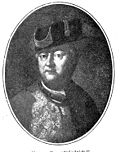 | 17 December 1707 | 1724–1745 | 13 August 1745 | Ernestine
Saxe-Hildburghausen | Caroline of Erbach-Fürstenau
19 June 1726
Fürstenau
four children |
| George Albert |  | 19 April 1695 | 1728–1739 | 12 June 1739 | Albertine
Saxe-Weissenfels-Barby | Auguste Louise of Württemberg-Oels
18 February 1721
Forst
no children | Left no descendants, and his land merged in Saxe-Weissenfels. |
| Saxe-Weissenfels-Barby merged in Saxe-Weissenfels |
| William Henry |  | 10 November 1691 | 1729–1741 | 26 July 1741 | Ernestine
Saxe-Eisenach | Albertine Juliane of Nassau-Idstein
15 February 1713
Idstein
no children
Anna Sophie Charlotte of Brandenburg-Schwedt
3 June 1723
Berlin
no children | Left no descendants: Saxe-Eisenach merged with Saxe-Weimar. |
| Saxe-Eisenach merged in Saxe-Weimar to form Saxe-Weimar-Eisenach |
| Ernest Augustus I | 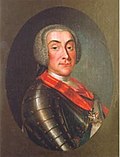 | 19 April 1688 | 1728–1741 | 19 January 1748 | Ernestine
Saxe-Weimar | Eleonore Wilhelmine of Anhalt-Köthen
2 November 1683
Nienburg
eight children
Sophie Charlotte of Brandenburg-Bayreuth
7 April 1734
Bayreuth
four children | Son of John Ernest III. Reunited under his rule the duchies of Saxe-Weimar and Eisenach. |
| 1741–1748 | Ernestine
Saxe-Weimar-Eisenach |
| Christian Ernest |  | 18 August 1683 | 1729–1745 | 4 September 1745 | Ernestine
Saxe-Coburg-Saalfeld | Christiane Fredericka of Koss
18 August 1724
Naitschau
(morganatic)
no children | Left no descendants. He was succeeded by his brother. |
| Charles Frederick I |  | 18 July 1712 | 1729–1743 | 28 March 1743 | Ernestine
Saxe-Meiningen | Unmarried | Brother of Ernest Louis II. Left no descendants. He was succeeded by his uncle. |
| Frederick III |  | 14 April 1699 | 1732–1772 | 10 March 1772 | Ernestine
Saxe-Gotha-Altenburg | Luise Dorothea of Saxe-Meiningen
17 September 1729
Gotha
eight children | He also served as regent for Duke Ernest Augustus II of Saxe-Weimar-Eisenach. |
Frederick Augustus II the Fat
(Friedrich August II) | 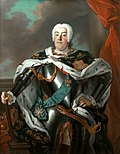 | 17 October 1696 | 1 February 1733 – 5 October 1763 | 5 October 1763 | Albertine
Electorate of Saxony | Maria Josepha of Austria
20 August 1719
Dresden
sixteen children | Son of Frederick Augustus I. Converted to Catholicism 1712. King of Poland 1734–1763. |
| John Adolph II | 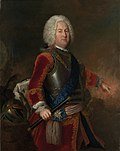 | 4 September 1685 | 1736–1746 | 16 May 1746 | Albertine
Saxe-Weissenfels-Querfurt | Johannette Antoinette Juliane of Saxe-Eisenach
9 May 1721
Eisenach
one child
Fredericka of Saxe-Gotha-Altenburg
27 November 1734
Altenburg
five children | Left no male descendants. After his death the Duchy was reannexed by the Electorate of Saxony. |
| Saxe-Weissenfels-Querfurt merged in the Electorate of Saxony |
| Frederick William IV | 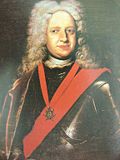 | 16 February 1679 | 1743–1746 | 10 March 1746 | Ernestine
Saxe-Meiningen | Unmarried | Brother of Ernest Louis I. Left no descendants. He was succeeded by his half-brother. |
| Regency of Caroline of Erbach-Fürstenau (1745-1748) | |
| Ernest Frederick III |  | 10 June 1727 | 1745–1780 | 23 September 1780 | Ernestine
Saxe-Hildburghausen | Louise of Denmark
1 October 1749
Copenhagen
one child
Christiane Sophie Charlotte of Brandenburg-Bayreuth
20 January 1757
Copenhagen
one child
Ernestine of Saxe-Weimar
1 July 1758
Bayreuth
three children |
| Francis Josias |  | 25 September 1697 | 1745–1764 | 16 September 1764 | Ernestine
Saxe-Coburg-Saalfeld | Anna Sophie of Schwarzburg-Rudolstadt
2 January 1723
Rudolstadt
eight children | Brother of Christian Ernest. He also served as regent for Duke Ernest Augustus II of Saxe-Weimar-Eisenach. |
| Anthony Ulrich |  | 22 October 1687 | 1746–1763 | 27 January 1763 | Ernestine
Saxe-Meiningen | Philippine Elisabeth Caesar
January 1711
morganatic
ten children
Charlotte Amalie of Hesse-Philippsthal
26 September 1750
Bad Homburg vor der Höhe
eight children | |
| Regency of Francis Josias, Duke of Saxe-Coburg-Saalfeld (1748-1755) | |
| Ernest Augustus II |  | 2 June 1737 | 1748–1758 | 28 May 1758 | Ernestine
Saxe-Weimar-Eisenach | Anna Amalia of Brunswick-Wolfenbüttel
16 March 1756
Brunswick
two children |
| Regency of Anna Amalia of Brunswick-Wolfenbüttel (1758-1775) | In 1815 his rank of Duke was elevated to Grand Duke; from 1815 Saxe-Weimar-Eisenach becomes a Grand Duchy. |
| Charles Augustus | 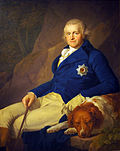 | 3 September 1757 | 1758–1828 | 14 June 1828 | Ernestine
Saxe-Weimar-Eisenach | Louise of Hesse-Darmstadt
3 October 1775
Karlsruhe
seven children |
Frederick Christian
(Friedrich Christian) |  | 5 September 1722 | 5 October 1763 – 17 December 1763 | 17 December 1763 | Albertine
Electorate of Saxony | Maria Antonia of Bavaria
13 June 1747
Munich
(by proxy)
20 June 1747
Dresden
(in person)
nine children | Son of Frederick Augustus II, raised Catholic. |
| Regency of Charlotte Amalie of Hesse-Philippsthal (1763-1779) | Left no descendants. He was succeeded by his brother. |
| Charles William |  | 19 November 1754 | 1763–1782 | 21 January 1782 | Ernestine
Saxe-Meiningen | Louise of Stolberg-Gedern
5 June 1780
Gedern
no children |
| Regency of Maria Antonia of Bavaria (1763-1768) | Son of Frederick Christian. His Electorate ceased with the fall of the Holy Roman Empire in 1806, and he became King of Saxony. |
Frederick Augustus III the Just
(Friedrich August III) | 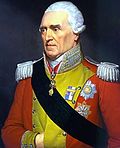 | 23 December 1750 | 17 December 1763 – 20 December 1806 | 5 May 1827 | Albertine
Electorate of Saxony | Amalie of Zweibrücken-Birkenfeld
17 January 1769
Mannheim
(by proxy)
29 January 1769
Dresden
(in person)
four children |
| In 1806 The Elector of Saxony became King of an independent Kingdom of Saxony. For the Kings that followed the electors, see below the Kingdom of Saxony. To continue the list of the multiple duchies that were contemporaries of this kingdom, follow this table. |
| Ernest Frederick |  | 8 March 1724 | 1764–1800 | 8 September 1800 | Ernestine
Saxe-Coburg-Saalfeld | Sophie Antoinette of Brunswick-Wolfenbüttel
23 April 1749
Wolfenbüttel
seven children | |
| Ernest II | 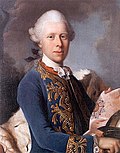 | 30 January 1745 | 1772–1804 | 20 April 1804 | Ernestine
Saxe-Gotha-Altenburg | Charlotte of Saxe-Meiningen
21 March 1769
Meiningen
four children | |
| George I |  | 4 February 1761 | 1782–1803 | 24 December 1803 | Ernestine
Saxe-Meiningen | Louise Eleonore of Hohenlohe-Langenburg
27 November 1782
Langenburg
four children | |
| Francis |  | 15 July 1750 | 1800–1806 | 9 December 1806 | Ernestine
Saxe-Coburg-Saalfeld | Sophie of Saxe-Hildburghausen
6 March 1776
Hildburghausen
no children
Augusta Reuss of Ebersdorf
13 June 1777
Ebersdorf
ten children | |
| Regency of Louise Eleonore of Hohenlohe-Langenburg (1803-1821) | |
| Bernard II |  | 17 December 1800 | 1803–1866 | 3 December 1882 | Ernestine
Saxe-Meiningen | Marie Frederica of Hesse-Kassel
23 March 1825
Kassel
two children |
| Augustus |  | 23 November 1772 | 1804–1822 | 17 May 1822 | Ernestine
Saxe-Gotha-Altenburg | Louise Charlotte of Mecklenburg-Schwerin
21 October 1797
Ludwigslust
one child
Karoline Amalie of Hesse-Kassel
24 April 1802
Kassel
no children | Left no male descendants. The land was inherited by his brother Frederick |
| Ernest I | 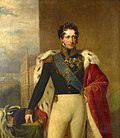 | 2 January 1784 | 1806–1844 | 29 January 1844 | Ernestine
Saxe-Coburg-Saalfeld (1800-1826)
Ernestine
Saxe-Coburg and Gotha (1826-1844) | Louise of Saxe-Gotha-Altenburg
3 July 1817
Gotha
two children
Marie of Württemberg
23 December 1832
Coburg
no children | Inherited Gotha from Frederick IX, but had to cede Saafeld to Saxe-Meiningen. The duchy changed its name to Saxe-Coburg and Gotha |
| Frederick IV |  | 28 November 1774 | 1822–1825 | 11 February 1825 | Ernestine
Saxe-Gotha-Altenburg | Unmarried | Brother of Augustus. Left no male descendants. The land was divided between Saxe-Coburg-Saalfeld and Saxe-Hildburghausen. |
| Saxe-Gotha-Altenburg divided between its neighbours Saxe-Coburg-Saalfeld and Saxe-Hildburghausen |
| Regency of Prince Joseph of Saxe-Hildburghausen (1780-1787) | Inherited Altenburg from Frederick IV, merging it with Hildburghausen. However, Frederick changed the name of the united duchy Saxe-Altenburg. |
| Frederick |  | 29 April 1763 | 1780–1834 | 29 September 1834 | Ernestine
Saxe-Hildburghausen
(1787-1826)
Ernestine
Saxe-Altenburg
(1826–1834) | Charlotte Georgine of Mecklenburg-Strelitz
3 September 1785
Hildburghausen
twelve children |
| Charles Frederick |  | 2 February 1783 | 1828–1853 | 8 July 1853 | Ernestine
Saxe-Weimar-Eisenach | Maria Pavlovna of Russia
3 August 1804
St. Petersburg
four children | |
| Joseph |  | 27 August 1789 | 1834–1848 | 25 November 1868 | Ernestine
Saxe-Altenburg | Amelia of Württemberg
24 April 1817
Kirchheim unter Teck
six children | He implemented several buildings in Altenburg, but his government was considered conservative and resistant to reform; for this, he was forced to abdicate during the civil revolution of 1848. Left no male descendants. He was succeeded by his brother George. |
| Ernest II |  | 21 June 1818 | 1844–1893 | 22 August 1893 | Ernestine
Saxe-Coburg and Gotha | Alexandrine of Baden
3 May 1842
Karlsruhe
no children | Left no descendants. He was succeeded by his nephews. |
| George |  | 24 July 1796 | 1848–1853 | 3 August 1853 | Ernestine
Saxe-Altenburg | Marie Louise of Mecklenburg-Schwerin
7 October 1825
Ludwigslust
three children | Brother of Joseph. |
| Charles Alexander |  | 24 June 1818 | 1853–1901 | 5 January 1901 | Ernestine
Saxe-Weimar-Eisenach | Sophie of the Netherlands
8 October 1842
The Hague
four children | |
| Ernest I |  | 16 February 1826 | 1853–1908 | 7 February 1908 | Ernestine
Saxe-Altenburg | Agnes of Anhalt-Dessau
28 April 1853
Ludwigslust
two children | Left no male descendants. He was succeeded by his nephew. |
| George II |  | 2 April 1826 | 1866–1914 | 25 June 1914 | Ernestine
Saxe-Meiningen | Charlotte of Prussia
18 May 1850
Berlin
four children
Feodora of Hohenlohe-Langenburg
23 October 1858
Langenburg
three children
Ellen Franz
18 March 1873
Liebenstein
(morganatic)
no children | |
| Alfred |  | 6 August 1844 | 1893–1900 | 30 July 1900 | Ernestine
Saxe-Coburg and Gotha | Maria Alexandrovna of Russia
23 January 1874
St Petersburg
six children | Son of Prince Albert of Saxe-Coburg and Gotha and Queen Victoria. Nephew of Ernest II. |
| Regency of Prince Ernst of Hohenlohe-Langenburg (1900-1905) | Son of Prince Leopold, Duke of Albany; Nephew of Alfred. Monarchy abolished in 1918. |
| Charles Edward | 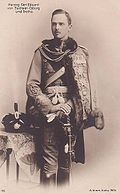 | 19 July 1884 | 1900–1918 | 6 March 1954 | Ernestine
Saxe-Coburg and Gotha | Victoria Adelaide of Schleswig-Holstein
11 October 1905
Schleswig
five children |
| William Ernest |  | 10 June 1876 | 1901–1918 | 24 April 1923 | Ernestine
Saxe-Weimar-Eisenach | Caroline Reuss of Greiz
30 April 1903
Bückeburg
no children
Feodora of Saxe-Meiningen
14 January 1910
Meiningen
four children | Grandson of Charles Alexander, as son of Charles Augustus, Hereditary Grand Duke of Saxe-Weimar-Eisenach. Monarchy abolished in 1918. |
| Ernest II |  | 31 August 1871 | 1908–1918 | 22 March 1955 | Ernestine
Saxe-Altenburg | Adelaide of Schaumburg-Lippe
17 February 1898
Bückeburg
(annulled 1920)
four children
Maria Triebel
15 July 1934
Trockenborn-Wolfersdorf
(morganatic)
no children | Grandson of George III, as son of Prince Moritz of Saxe-Altenburg. Monarchy abolished in 1918. |
| Bernard III |  | 1 April 1851 | 1914–1918 | 16 January 1928 | Ernestine
Saxe-Meiningen | Charlotte of Prussia
18 February 1878
Berlin
two children | Monarchy abolished in 1918. |
